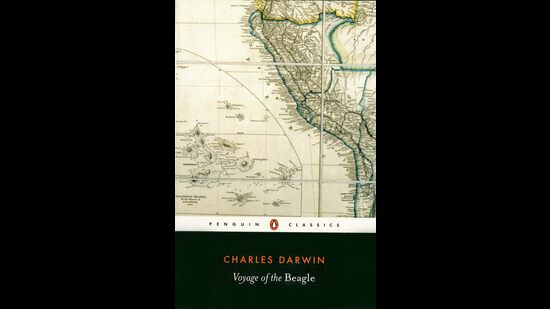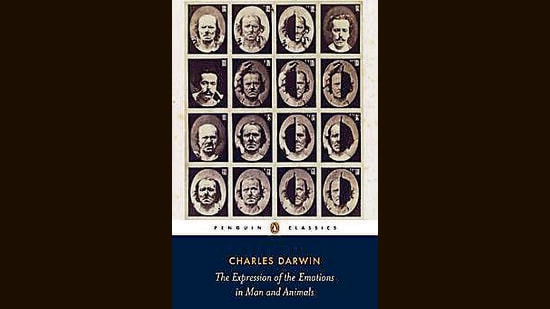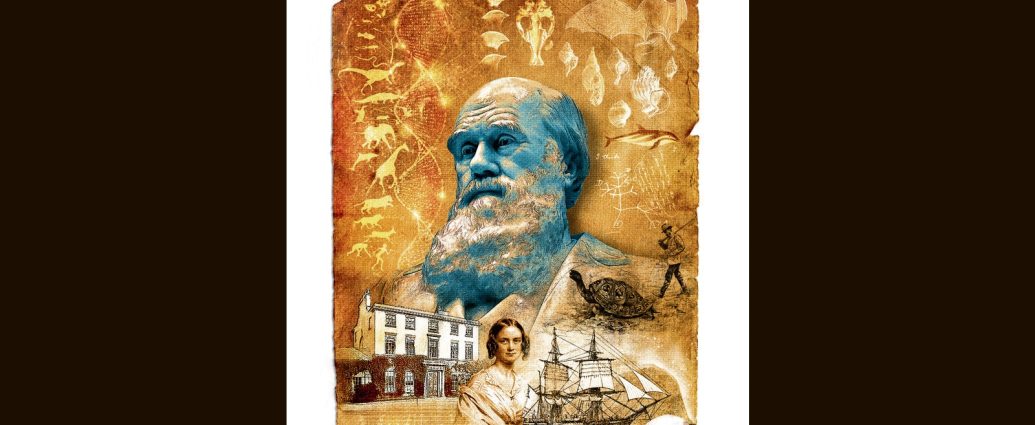In 1859, a single man changed forever how we use the word evolved.
The term migrated to English as a way to indicate significant movement (as with military manoeuvres). Its roots were in the Latin evolutio, for the unfurling of a scroll.
Now, Charles Darwin was suggesting that all living creatures had “evolved” through the inheritance of small variations that helped them compete, survive and reproduce.
“There is grandeur in this view of life, with its several powers, having been originally breathed into a few forms or into one,” he writes, in On the Origin of Species (1859), adding, “And that, whilst this planet has gone cycling on according to the fixed law of gravity, from so simple a beginning endless forms most beautiful and most wonderful have been, and are being, evolved.”
It all began, for him, with a question that nibbled away at him, as he sailed through unfamiliar islands on the HMS Beagle, a young naturalist in the company of surveyors and researchers, all on a scientific mission. The question that formed was this: What caused so many kinds of living things to take shape in the world, some with only the tiniest physical differences?
It was a dramatic question to ask — arguably as dramatic as the one Nicolaus Copernicus posed some 300 years earlier: Is it possible that everything in the skies does not revolve around our Earth?
What does it take to become the kind of person that questions the world in this way? How do they deal with the ripple effects of the answers they confront? And what might we borrow from such a spirit of inquiry, in our conflicted, troubled age?
“We should perhaps think twice about the juggernaut of natural selection that we are chipping away at through careless consumption,” says Jahnavi Phalkey, a science historian and founding director of Science Gallery Bengaluru, “What we are perhaps missing most today is the grand intellectual ambition to ask unreasonable questions about this intriguing planet we inhabit.” Here, then, is a look at Darwin’s unique legacy, 215 years after his birth.
1. Charles Darwin was born into a wealthy family, in 1809, the fifth of six children. He grew up exploring the fields and woodlands around the family’s seven-acre estate, in the market town of Shrewsbury in England.
His father, Robert Darwin, was a physician; his mother, Susannah Wedgwood Darwin, was from the family renowned for its brand of luxurious fine-bone-china crockery. The Wedgwoods and Darwins were linked by friendship, marriage, social status and ideas. Both families had advocated, for instance, for the end of slavery. Charles Darwin and his sister Caroline both married Wedgwoods too.
2. Darwin’s mother died when he was eight. He grew up watched over by his elder sisters, Marianne Darwin, Caroline Darwin and Susan Darwin. “All were extremely kind and affectionate towards me during their whole lives,” he would write in his memoir, published in 1887. Caroline, nine years older and with an interest in botany, tutored him before he left for boarding school, looked after his journals while he was on the Beagle from 1831 to ’36, and later critiqued his writing.
3. Darwin’s grandfathers — Erasmus Darwin, a physician, and Josiah Wedgwood, founder of the Wedgwood company — influenced him too. They were both members of the Lunar Society, which met to discuss the latest industrial inventions and scientific experiments.
Erasmus floated his own evolutionary theory, in some ways a precursor to Darwin’s. Zoonomia; or the Laws of Organic Life (1794–96) is a two-volume work that explores ideas of species competition and sexual selection, among other themes.
4. From an early age, the boy maintained collections of plants and insects; made up stories about his shells, coins and rocks. In his autobiography, he writes that “as a little boy I was much given to inventing deliberate falsehoods… for the sake of causing excitement. For instance, I once gathered much valuable fruit from my Father’s trees and hid them in the shrubbery, and then ran in breathless haste to spread the news that I had discovered a hoard of stolen fruit.”
5. In 1825, Darwin was accepted at Edinburgh University, where his father wished him to study medicine and become a physician. But the surgeries (then often carried out without anaesthetics) traumatised the 16-year-old. When his father proposed that he study to be a priest instead, he joined Christ’s College, Cambridge, in 1828 (a degree in Arts was a prerequisite).
At Cambridge, he struck up a friendship with botany professor named John Henslow (who was about 13 years his senior), and, soon after Darwin graduated in 1831, it was Henslow who wrote to him, asking if he would like to join Royal Navy commander and scientist Robert FitzRoy, who was captaining the HMS Beagle, on a survey of South America.
6. Darwin, now 22, almost didn’t make it onto the ship. His father was deeply averse to the idea. His objections included the idea that the voyage was “disreputable” to the character of a future clergyman, and “a wild scheme” that must have been offered to trained naturalists who declined it; that his accommodations would be uncomfortable, and it would be a “useless undertaking”. (It’s strange, isn’t it, how familiar the arguments seem to anyone who has tried to convince a parent of the merits of a grand adventure?)
7. The Beagle would, of course, be the opportunity of a lifetime.
In the five years that Darwin spent studying the zoology and geology of the lands they visited, he unearthed unfamiliar fossils, encountered giant tortoises and marine iguanas that seemed to defy time, collected specimens of strange birds and insects.
Through it all, he maintained an expansive geological diary, several field notebooks, and a diary that later evolved into the famous Journal of Researches (1839), later reprinted, over and over, as The Voyage of the Beagle.

8. The journey towards his theory of evolution hinged on three primary clues, says Darwin scholar and science historian John van Wyhe. First, the discovery of “great fossil animals covered with armour like that on the existing armadillos” in central Argentina, embedded in which he found mammalian and molluscan remains.
Second, the way in which, as he put it, “closely allied animals replace one another in proceeding southwards over the Continent”. And third, the gradual modifications he saw in species across the Galapagos Islands alone, species that were separated only by the minor differences in their habitats. “The subject haunted me,” Darwin later wrote.
9. Once the Beagle returned to England, he continued his research, sending questionnaires to other scientists voyaging to distant lands, as well as to farmers, livestock breeders and gardeners. He wanted to prove through direct evidence that a species had been “modified”.
He only published On the Origin of Species 23 years later, in 1859. Historians have speculated that, even then, he only felt he could because the English naturalist Alfred Wallace had presented a similar theory in an essay the previous year.
Some historians refer to this period as “Darwin’s delay”, and suggest that he was afraid of being ridiculed, feared persecution, or feared upsetting the social order.
van Wyhe believes there is no truth to this. He points to the first page of On the Origin of Species, where Darwin writes that he started working on the theory of evolution in 1837, “drew up some short notes” in 1842 and enlarged on these in 1844, and that “from that period to the present day I have steadily pursued the same object”.

10. Now, in Wallace, 14 years his junior, Darwin found a protegee, sounding board and friend. Both had spent years studying natural history in South America. Wallace’s observations impressed Darwin.
According to the Darwin Correspondence Project, an online repository created by University of Cambridge, Wallace trusted Darwin and valued his opinion enough to share with him a draft of his own theory of descent, in 1858. Soon after, Darwin wrote to the geologist Charles Lyell, “I never saw a more striking coincidence… if Wallace had my M.S. sketch written out in 1842 he could not have made a better short abstract!”
The two men presented a joint paper on evolution at the Linnean Society of London meeting that year.
“You are the only man I ever heard of who persistently does himself an injustice & never demands justice,” Darwin wrote to Wallace in 1869. The latter maintained that the theory of natural selection was “actually yours and yours only”. “You had worked it out in details I had never thought of, years before I had a ray of light on the subject, & my paper would never have convinced anybody or been noticed as more than an ingenious speculation, whereas your book has revolutionised the study of Natural History, & carried away captive the best men of the present Age,” Wallace wrote to Darwin, in 1864.
11. Some historians argue that Darwin put off publication out of respect for his wife Emma Wedgwood Darwin, a devout Christian. He was 30 when they wed; she, 31. They lived well, first in London, then in Kent. A few months before they were engaged, however, Darwin scribbled the still-famous list of the pros and cons of marriage. “Constant companion, (& friend in old age) who will feel interested in one”, “children—(if it Please God)”, “object to be beloved & played with”, went the pros. Cons included the loss of “freedom to go where one liked”, “ the expense & anxiety of children”, and the sentiment “how should I manage all my business if I were obliged to go every day walking with my wife”.
12. Still, by all accounts, theirs was a happy marriage. Emma also stood by him and his work. In an 1861 letter to him, she refers indirectly to the fracas his theory caused. “I cannot tell you the compassion I have felt for all your sufferings for these weeks past. Nor the gratitude I have felt for the cheerful & affectionate looks you have given me when I know you have been miserably uncomfortable,” she writes.
13. In his diaries and autobiography, there are indications that Darwin struggled to reconcile his theory with his own religious beliefs as well. He notes that he was quite orthodox while on board the Beagle, but slowly grew to question the holy texts.
14. Through his life, Darwin was somewhat troubled by bouts of ill health, relating mainly to his digestive system. Of the 10 children he and Emma had, three were lost in childhood and he worried that he had passed his “poor constitution” down to them all. He wrote often, in his diaries, of being unable to work when they were ill.
A week after the death of their second child, Anne, aged 10, he wrote: “We have lost the joy of the Household… Occasionally she had a pretty coquettish manner towards me; the memory of which is charming: she often used exaggerated language, & when I quizzed her by exaggerating what she had said, how clearly can I now see the little toss of the head & exclamation of “Oh Papa what a shame of you”.
15. In his professional life, Darwin faced criticism not just from the clergy and the devout, but from women as well. Much of this relates to views expressed in The Descent of Man, and Selection in Relation to Sex (1871), in which he argues that evolution made men superior to women. “Man is more courageous, pugnacious, and energetic than woman, and has a more inventive genius,” he wrote. “If two lists were made of the most eminent men and women in poetry, painting, sculpture, music… history, science, and philosophy, with half-a-dozen names under each subject, the two lists would not bear comparison.”
Among his most vocal early opponents on this front was Antoinette Brown Blackwell, the first woman minister in the US. In 1875, she published The Sexes Throughout Nature, a first-of-its-kind feminist critique of Darwin.
16. Around the world, meanwhile, his larger theory of evolution would be embraced for reasons ranging from the personal and political to the geopolitical. The theory became a matter of prestige in an Arab world contending with colonial rule. “Darwin, in Egypt, became a way to counter imperial cultural hegemony with one of its own weapons: science,” says science historian Jahnavi Phalkey.
17. In addition to the origins of species, Darwin was fascinated by the role of expressions in communication and evolution. Scientists were then just beginning to ask: Why is it that we “know” what someone is feeling, from an expression; are expressions thus universal?
Darwin studied “expressions” in monkeys, dogs, cats and horses, and kept some records of his children’s expressions and gestures too. Some are universal and have an evolutionary basis, as they aid in survival, reproduction and communication, he noted, in The Expression of the Emotions in Man and Animals (1872), in a finding that has since been verified by science.

18. As Darwin aged, his ailments intensified, confining him to bed for weeks or months at a time. He consulted specialists, tried special diets, had a special bath constructed in his home and dabbled with ice therapy. His health reportedly improved whenever his wife was able to urge him to take a holiday. But, he would write in his diary, idleness did not sit well with him. Science was “the only thing that makes life endurable”.
19. When his health permitted, he enjoyed attending soirees and otherwise socialising with close friends, among whom were the poet Alfred Lord Tennyson, the mathematician and inventor Charles Babbage and the novelist George Eliot.
20. Darwin died in 1882, aged 73, at his home in Downe, Kent. He was laid to rest at Westminster Abbey. Already, by this time, he was one of the most influential voices in the history of science. In its obituary, The Spectator noted that “England has lost the most original, as well as far the most celebrated, of modern men of science.”
The Times drew parallels between his contribution and that of Isaac Newton (1642–1727). “Through his influence the whole method of seeking after knowledge has been changed,” this obituary stated, “and the increasing rapidity with which the results are every day developed becomes more and more bewildering.”
